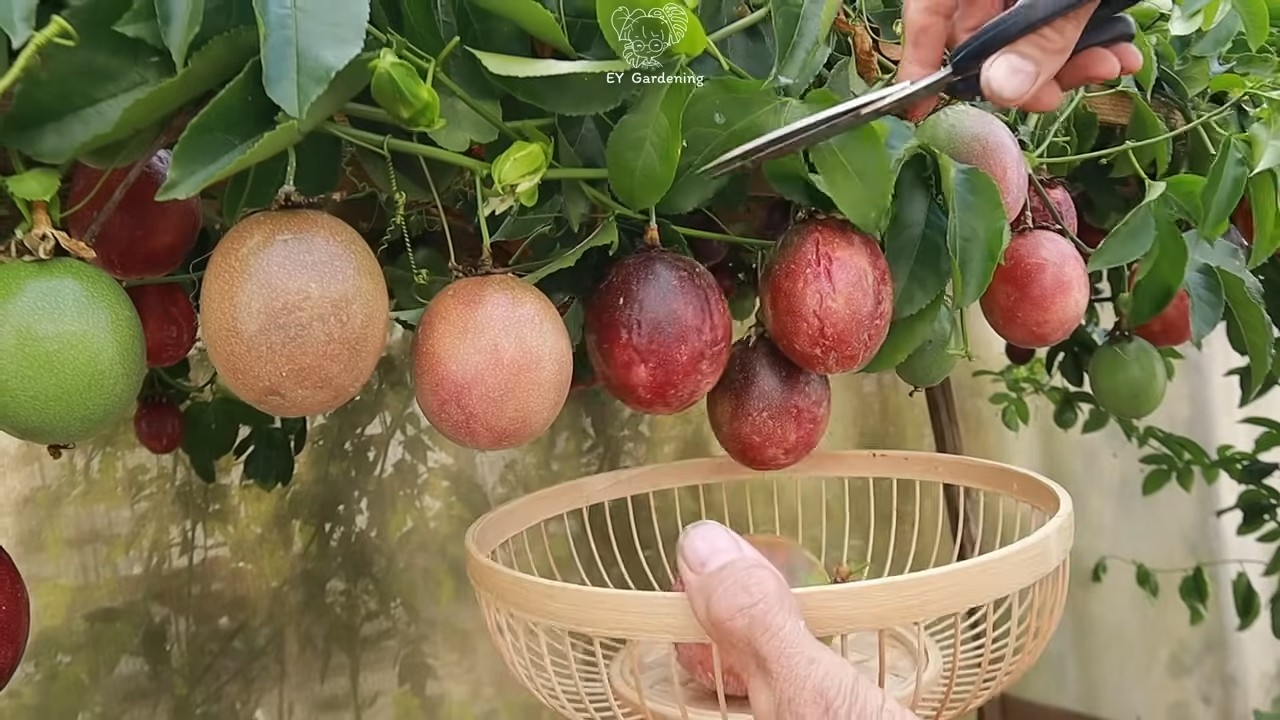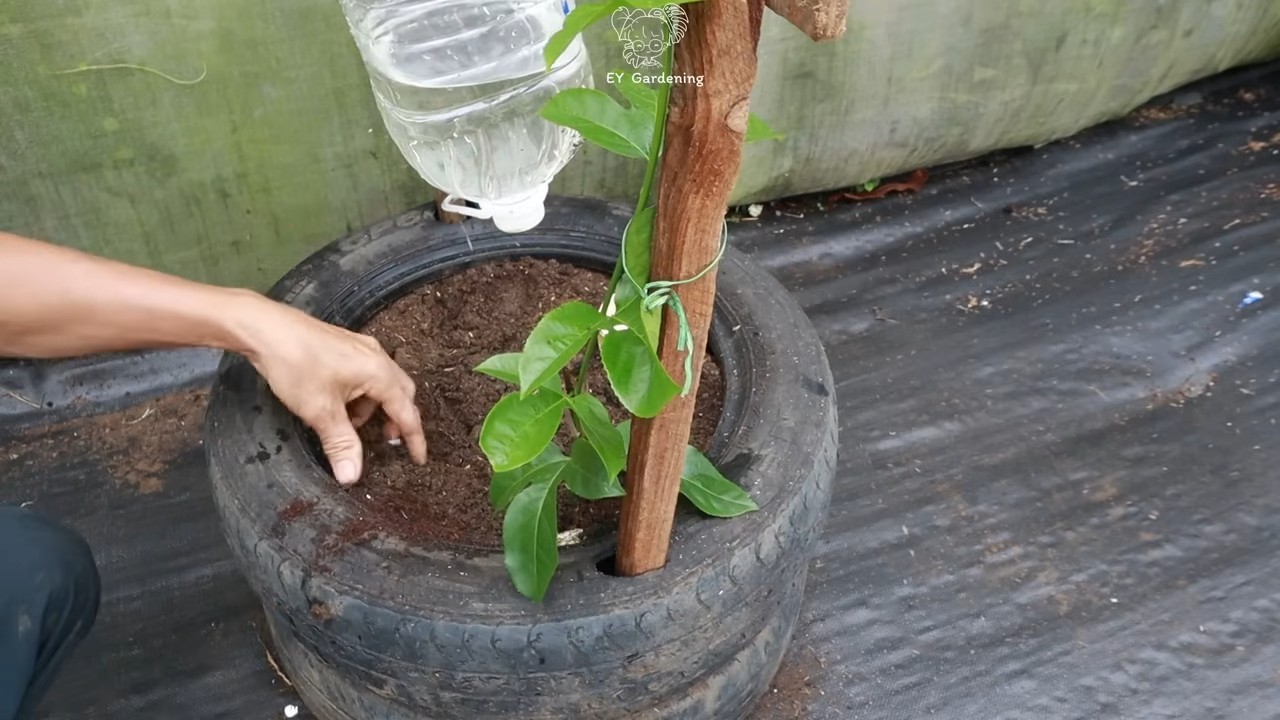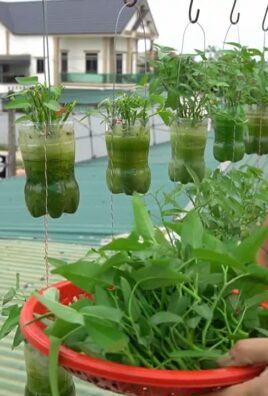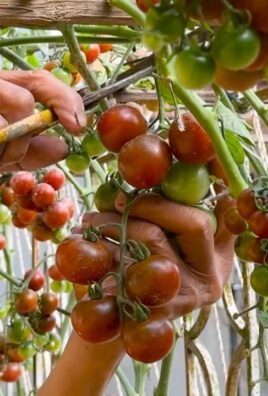Grow passion fruit at home and transform your garden into a tropical paradise! Imagine plucking juicy, fragrant passion fruit straight from your own vine – it’s easier than you think, and this DIY guide will show you how. For centuries, passion fruit has been cherished in South America, not only for its delicious taste but also for its purported medicinal properties. The Aztecs even believed it possessed calming effects.
But beyond its rich history, why should you learn to grow passion fruit at home? Well, store-bought passion fruit can be expensive and often lacks the vibrant flavor of homegrown varieties. Plus, cultivating your own vine is incredibly rewarding! You’ll not only enjoy a bountiful harvest, but you’ll also add a stunning, exotic touch to your garden.
This article is packed with simple, step-by-step instructions and clever hacks to ensure your passion fruit vine thrives, even if you’re a complete beginner. We’ll cover everything from choosing the right variety and preparing the soil to providing the perfect support structure and tackling common pests. Get ready to unleash your inner gardener and experience the joy of growing your own delicious passion fruit!

Growing Passion Fruit at Home: A Comprehensive DIY Guide
Hey there, fellow gardening enthusiasts! I’m so excited to share my passion (pun intended!) for growing passion fruit at home. It might seem intimidating, but trust me, with a little patience and the right know-how, you can enjoy your own homegrown, deliciously tangy passion fruit. This guide will walk you through every step, from choosing the right variety to harvesting your bounty. Let’s get started!
Choosing the Right Passion Fruit Variety
Before you even think about planting, you need to decide which type of passion fruit is right for you. There are several varieties, each with its own unique characteristics. Here’s a quick rundown:
* **Purple Passion Fruit (Passiflora edulis):** This is the most common variety, known for its small, dark purple fruit with a rich, tangy flavor. It’s relatively cold-hardy, making it a good choice for cooler climates.
* **Yellow Passion Fruit (Passiflora edulis flavicarpa):** This variety produces larger, yellow fruit that’s more acidic than the purple variety. It’s also more vigorous and disease-resistant, but less cold-hardy.
* **Giant Granadilla (Passiflora quadrangularis):** As the name suggests, this variety produces very large fruit, up to a foot long! The flavor is milder and less acidic than the other two.
* **Sweet Granadilla (Passiflora ligularis):** This variety has orange-yellow skin and a sweet, aromatic pulp. It’s less common but worth seeking out if you prefer a sweeter passion fruit.
Consider your climate and taste preferences when making your choice. I personally prefer the purple passion fruit for its intense flavor and relative hardiness.
Preparing for Planting
Okay, you’ve chosen your variety! Now, let’s get ready to plant. This involves selecting the right location, preparing the soil, and choosing between starting from seed or using a seedling.
* **Location, Location, Location:** Passion fruit vines need at least 6-8 hours of direct sunlight per day. They also need a sturdy support structure, like a trellis, fence, or arbor, to climb on. Choose a location that’s sheltered from strong winds, as these can damage the delicate vines.
* **Soil Preparation is Key:** Passion fruit vines thrive in well-draining soil that’s rich in organic matter. Before planting, amend the soil with compost, aged manure, or other organic materials. The ideal soil pH is between 6.0 and 7.5.
* **Seed vs. Seedling:** You can grow passion fruit from seed, but it’s a slower process and the resulting plant may not be true to type (meaning the fruit might not be exactly like the parent plant). I recommend starting with a seedling from a reputable nursery. This will give you a head start and ensure you get the variety you want.
Step-by-Step Planting Guide
Alright, let’s get our hands dirty! Here’s how to plant your passion fruit vine:
1. **Dig the Hole:** Dig a hole that’s twice as wide and as deep as the root ball of your seedling.
2. **Amend the Soil (Again!):** Mix some compost or aged manure into the soil you removed from the hole. This will provide extra nutrients for your new vine.
3. **Gently Remove the Seedling:** Carefully remove the seedling from its container, being careful not to damage the roots. Gently loosen any circling roots.
4. **Position the Seedling:** Place the seedling in the hole, making sure the top of the root ball is level with the surrounding soil.
5. **Backfill the Hole:** Fill the hole with the amended soil, gently tamping it down around the roots.
6. **Water Thoroughly:** Water the newly planted vine thoroughly to settle the soil and help the roots establish.
7. **Mulch Around the Base:** Apply a layer of mulch around the base of the vine to help retain moisture, suppress weeds, and regulate soil temperature. Use organic mulch like straw, wood chips, or shredded leaves.
8. **Provide Support:** Make sure the vine has access to its support structure. Gently guide the tendrils towards the trellis or fence.
Caring for Your Passion Fruit Vine
Now that your passion fruit vine is planted, it’s time to provide the care it needs to thrive. This includes watering, fertilizing, pruning, and pest control.
* **Watering Wisely:** Passion fruit vines need consistent moisture, especially during the growing season. Water deeply whenever the top inch of soil feels dry to the touch. Avoid overwatering, as this can lead to root rot.
* **Fertilizing for Growth:** Feed your passion fruit vine regularly with a balanced fertilizer. I like to use a fertilizer with an NPK ratio of 10-10-10. Apply the fertilizer according to the package directions, usually every 4-6 weeks during the growing season. You can also use organic fertilizers like compost tea or fish emulsion.
* **Pruning for Productivity:** Pruning is essential for maintaining a healthy and productive passion fruit vine. Prune in late winter or early spring, before new growth begins. Remove any dead, damaged, or diseased wood. Also, prune back any overly vigorous growth to encourage branching and fruit production.
* **Pest and Disease Control:** Passion fruit vines can be susceptible to various pests and diseases. Keep an eye out for common pests like aphids, spider mites, and scale insects. Treat infestations with insecticidal soap or neem oil. Prevent fungal diseases by ensuring good air circulation and avoiding overwatering.
Training Your Passion Fruit Vine
Training your passion fruit vine is crucial for maximizing fruit production and keeping it manageable. Here’s how I do it:
1. **Establish a Main Stem:** Choose a strong, healthy stem to be the main trunk of the vine. Tie it loosely to the support structure.
2. **Encourage Lateral Growth:** As the vine grows, encourage lateral growth by pinching off the tips of the main stem. This will promote branching and create a fuller vine.
3. **Train the Laterals:** Train the lateral branches along the trellis or fence, spacing them evenly. This will allow for good air circulation and sunlight penetration.
4. **Remove Unwanted Growth:** Regularly remove any suckers or unwanted growth that sprouts from the base of the vine. These will compete with the main vine for nutrients and energy.
Pollination: Helping Nature Along
Passion fruit flowers are beautiful and fragrant, but they need to be pollinated in order to produce fruit. While bees and other insects can pollinate passion fruit flowers, sometimes they need a little help, especially if you’re growing them indoors or in an area with limited pollinator activity.
* **Hand Pollination:** Hand pollination is a simple and effective way to ensure fruit set. Use a small paintbrush or cotton swab to transfer pollen from the anthers (the male part of the flower) to the stigma (the female part of the flower). Do this in the morning, when the flowers are open and the pollen is fresh.
Harvesting Your Passion Fruit
The moment you’ve been waiting for! Harvesting your own passion fruit is incredibly rewarding. Here’s how to know when they’re ready:
* **Color Change:** The fruit will change color from green to purple or yellow, depending on the variety.
* **Wrinkled Skin:** The skin will become slightly wrinkled. This is a sign that the fruit is ripe and juicy.
* **Falling Fruit:** Ripe passion fruit will often fall from the vine. You can also gently tug on the fruit to see if it’s ready to come off.
Don’t be afraid to let them drop! I usually let mine fall naturally, as this ensures they’re perfectly ripe.
Once harvested, passion fruit can be stored at room temperature for a few days or in the refrigerator for up to a week.
Troubleshooting Common Problems
Even with the best care, you might encounter some problems along the way. Here are a few common issues and how to address them:
* **Lack of Fruit:** If your passion fruit vine isn’t producing fruit, it could be due to a lack of pollination, insufficient sunlight, or nutrient deficiencies. Try hand-pollinating the flowers, ensuring the vine gets enough sunlight, and fertilizing regularly.
* **Yellowing Leaves:** Yellowing leaves can be a sign of overwatering, nutrient deficiencies, or pest infestations. Check the soil moisture, fertilize with a balanced fertilizer, and inspect the leaves for pests.
* **Root Rot:** Root rot is a fungal disease that can occur in poorly draining soil. Prevent root rot by planting in well-draining soil and avoiding overwatering. If you suspect root rot, improve drainage and treat with a fungicide.
Enjoying Your Homegrown Passion Fruit
Congratulations! You’ve successfully grown your own passion fruit. Now it’s time to enjoy the fruits of your labor. Here are a few ideas:
* **Eat it Fresh:** Simply cut the fruit in half and scoop out the pulp with a spoon. Enjoy the tangy, aromatic flavor on its own or add it to yogurt, ice cream, or smoothies.
* **Make Juice:** Blend the pulp with water and strain

Conclusion
So, there you have it! Growing passion fruit at home is not only achievable, but it’s also incredibly rewarding. Forget those expensive, often underwhelming fruits from the grocery store. Imagine stepping into your own backyard and harvesting vibrant, fragrant passion fruit bursting with tropical flavor. This DIY trick empowers you to cultivate your own supply of this exotic delight, ensuring freshness and quality you simply can’t find elsewhere.
This isn’t just about saving money; it’s about connecting with nature, understanding the growing process, and experiencing the satisfaction of nurturing something from a seed or cutting to a bountiful harvest. The intense aroma that fills the air as your passion fruit vine flowers, the anticipation as the fruits ripen, and the explosion of flavor when you finally taste your homegrown passion fruit – these are experiences that make the effort worthwhile.
Beyond the basic method, there’s plenty of room for experimentation. Try different varieties of passion fruit to discover your favorite flavor profile. Some varieties are sweeter, while others have a more tart and tangy taste. You can also explore different trellising methods to optimize space and sunlight exposure. Consider adding companion plants to your passion fruit vine to attract pollinators and deter pests naturally. For example, planting basil or marigolds nearby can help keep unwanted insects away.
Don’t be intimidated if you’re a beginner gardener. Passion fruit vines are surprisingly resilient and adaptable. With a little patience and the right care, you’ll be enjoying your own homegrown passion fruit in no time. Remember to provide adequate sunlight, well-draining soil, and a sturdy support structure for your vine to climb. Regular watering and fertilization will also contribute to healthy growth and abundant fruit production.
We encourage you to take the plunge and try this DIY trick for growing passion fruit at home. It’s a fantastic project that will bring joy and delicious fruit to your life. Once you’ve experienced the satisfaction of harvesting your own passion fruit, you’ll never look at store-bought fruit the same way again.
Don’t forget to share your experiences with us! We’d love to hear about your successes, challenges, and any variations you’ve tried. Post photos of your passion fruit vines, share your favorite recipes using homegrown passion fruit, and let us know what you’ve learned along the way. Together, we can create a community of passionate passion fruit growers and inspire others to embark on this rewarding journey. So, get your hands dirty, embrace the challenge, and start growing your own passion fruit today! You’ll be amazed at what you can achieve.
Frequently Asked Questions (FAQ)
What is the best time of year to plant passion fruit?
The best time to plant passion fruit depends on your climate. In warmer climates with mild winters, you can plant passion fruit year-round. However, in cooler climates, it’s best to plant in the spring or early summer after the last frost. This gives the vine ample time to establish itself before the colder months arrive. Planting during the warmer months allows the roots to develop quickly and the vine to grow vigorously. Avoid planting during the hottest part of summer, as the intense heat can stress the young plant.
How much sunlight does passion fruit need?
Passion fruit vines thrive in full sun, requiring at least 6-8 hours of direct sunlight per day. Sunlight is crucial for photosynthesis, which is the process by which plants convert light energy into chemical energy for growth and fruit production. Insufficient sunlight can lead to weak growth, reduced flowering, and poor fruit set. Choose a location in your garden that receives ample sunlight throughout the day. If you live in a particularly hot climate, providing some afternoon shade can help prevent the leaves from scorching.
What type of soil is best for passion fruit?
Passion fruit prefers well-draining soil that is rich in organic matter. The soil should be slightly acidic to neutral, with a pH between 6.0 and 7.0. Good drainage is essential to prevent root rot, which is a common problem for passion fruit vines. Before planting, amend the soil with compost, well-rotted manure, or other organic materials to improve its fertility and drainage. You can also add perlite or vermiculite to the soil to enhance drainage. Avoid heavy clay soils, as they tend to retain too much water.
How often should I water my passion fruit vine?
Water your passion fruit vine regularly, especially during dry periods. The soil should be kept consistently moist but not waterlogged. Water deeply whenever the top inch of soil feels dry to the touch. During hot weather, you may need to water more frequently. Avoid overhead watering, as this can promote fungal diseases. Instead, water at the base of the plant, focusing on the root zone. Mulching around the base of the vine can help retain moisture in the soil and suppress weed growth.
How do I fertilize my passion fruit vine?
Passion fruit vines are heavy feeders and require regular fertilization to support healthy growth and fruit production. Use a balanced fertilizer with a ratio of 10-10-10 or 14-14-14. Apply the fertilizer according to the manufacturer’s instructions, typically every 4-6 weeks during the growing season. You can also supplement with organic fertilizers such as compost tea or fish emulsion. Avoid over-fertilizing, as this can lead to excessive vegetative growth at the expense of fruit production.
How do I prune my passion fruit vine?
Pruning is essential for maintaining the shape and productivity of your passion fruit vine. Prune regularly to remove dead, damaged, or diseased growth. You can also prune to control the size and shape of the vine and to encourage branching. The best time to prune is after the main fruiting season. Remove any unwanted growth and shorten long, trailing vines. Be careful not to prune too heavily, as this can reduce fruit production.
How long does it take for passion fruit to produce fruit?
Passion fruit vines typically start producing fruit within 1-2 years of planting. However, the exact time frame can vary depending on the variety, growing conditions, and care provided. Seedlings may take longer to produce fruit than grafted plants. To encourage early fruiting, ensure that your vine receives adequate sunlight, water, and nutrients. Proper pruning and trellising can also help promote fruit production.
What are some common pests and diseases of passion fruit?
Passion fruit vines can be susceptible to various pests and diseases, including aphids, spider mites, scale insects, and fungal diseases such as root rot and fusarium wilt. Regularly inspect your vine for signs of pests or diseases. Treat infestations promptly with appropriate insecticides or fungicides. Good cultural practices, such as proper watering, fertilization, and pruning, can help prevent many pest and disease problems.
Can I grow passion fruit in a container?
Yes, you can grow passion fruit in a container, especially if you live in a cooler climate where you need to bring the vine indoors during the winter. Choose a large container with good drainage holes. Use a well-draining potting mix that is rich in organic matter. Provide a sturdy trellis or support structure for the vine to climb. Water and fertilize regularly, and protect the vine from frost. Container-grown passion fruit vines may not produce as much fruit as those grown in the ground, but they can still provide a rewarding harvest.
How do I know when passion fruit is ripe?
Passion fruit is ripe when the skin becomes wrinkled and slightly soft to the touch. The color of the fruit will also change depending on the variety, typically turning from green to purple, yellow, or red. Ripe passion fruit will often fall from the vine on its own. You can also gently tug on the fruit to see if it comes off easily. The fruit should have a strong, fragrant aroma. Once harvested, passion fruit can be stored at room temperature for a few days or in the refrigerator for up to a week.




Leave a Comment